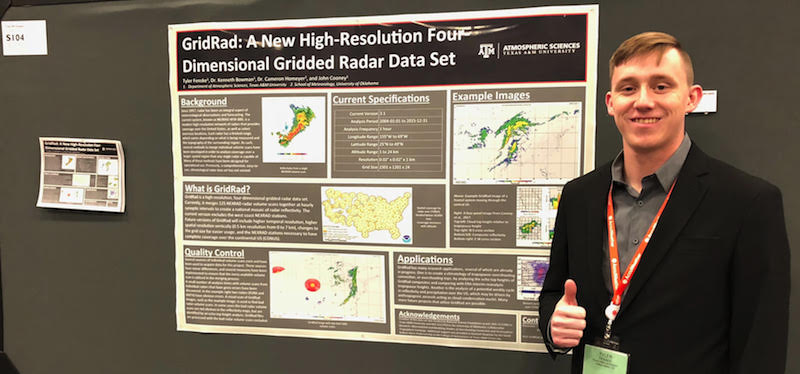Life-long Love Of Weather Brought This Aggie To Texas A&M Meteorology
Senior Tyler Fenske is a second-generation Aggie who found his perfect fit in Texas A&M University’s meteorology program, in the Department of Atmospheric Sciences, and now he helps high school students find their place, too.
Feb 20, 2018
Fenske's interest in weather started long before his college journey, he said.
“I’ve been interested in weather since I was a little kid; my mom has a video of me doing a pretend weather forecast in front of a blank TV,” Fenske said. “I’ve always been fascinated by nature, the earth and weather.”
Raised in Katy, Texas, he grew up being interested in weather, and he also spent his childhood watching Texas A&M football games and visiting Aggieland. His mother, Danna Fenske, graduated from Texas A&M in 1985. When the time came for him to pick a college to attend, it was simple. “A&M has a strong meteorology program so it was really a natural fit for me,” Fenske said.

During his time at Texas A&M, he has been involved in many activities, worked as a research technician for the past two years and participated in numerous undergraduate research projects. He is involved with the Student Operated ADRAD Project (SOAP) and many others.
“The ADRAD is the radar dish on top of the O&M building,” he explained. “We learn how to run it, and we learn how to do weather balloon launches and interpret those. In addition to all of that, we pick a theme each summer and we do various projects on that.”
“One year I was a team leader, and the theme that year was lightning and lightning detector research. We had a homemade lightning detector, and we bought four top-of-the-line detectors that are available for people to put on their homes, and we compared them all to a professional network.”
Fenske helped his peers in SOAP develop a device to assist storm chasers in the summer of 2017.
“We made this device where when people are storm chasing, it can track their location even when there is no cell coverage, and when there is no internet.”
As a research technician, Fenske works with Dr. Ken Bowman, a professor in the Department of Atmospheric Sciences, working with RADAR data. “There are about 140 radars all over the nation and we take each of those, since they have a limited range, and we combine them all into a national mosaic,” Fenske explained. “Those exist operationally for forecasting, but what we are doing is making a model that is more climatological, so it’s more for research studies.”
The first of its kind, this national RADAR mosaic climate model is nearly complete, he said, and now they are transitioning the research into using the model. Fenske is researching the effects of pollution-sourced aerosols on precipitation, specifically in relation to work-week variations in industrial pollution levels.
“We are going to work on seeing if the pollution and the aerosols, which we know vary in the week, generate a noticeable effect on clouds and precipitation,” he said.
Along with undergraduate research, Fenske is also an officer in the Texas A&M Chapter of the American Meteorological Society (TAMSCAMS) and is the undergraduate coordinator for Texas Aggie Storm Chasers (TASC).
He is also the lead student recruiter in the college’s undergraduate recruitment team (URT). “We help prospective high school students get a feel for the college and the university and talk to them about our experiences and the majors and the opportunities they’ll have,” he explained. “The big thing for URT is GeoX, which is a week-long summer program where we invite high school students to spend a week on campus.”
GeoX participants get to stay in a dorm on campus and experience Aggieland for an entire week. Each day they get to experience and learn about a different major within the College of Geosciences.
“I participated in that as a high school student and it really kind of sealed the deal for me to come here and study meteorology, so it's my way to carry that on,” he said.
After graduating this May, Fenske plans on attending graduate school to study climate science and then continue his education and get a Ph.D.
For students looking to follow his footsteps and get a degree in meteorology, he encourages them to not be intimidated by the math and science courses that are foundational to the degree.
“You don’t have to be good at it, but you have to be willing to tolerate it. You have to enjoy meteorology, and not think of it as just something cool that you are studying.”
By Taylor Fuechec ‘18

